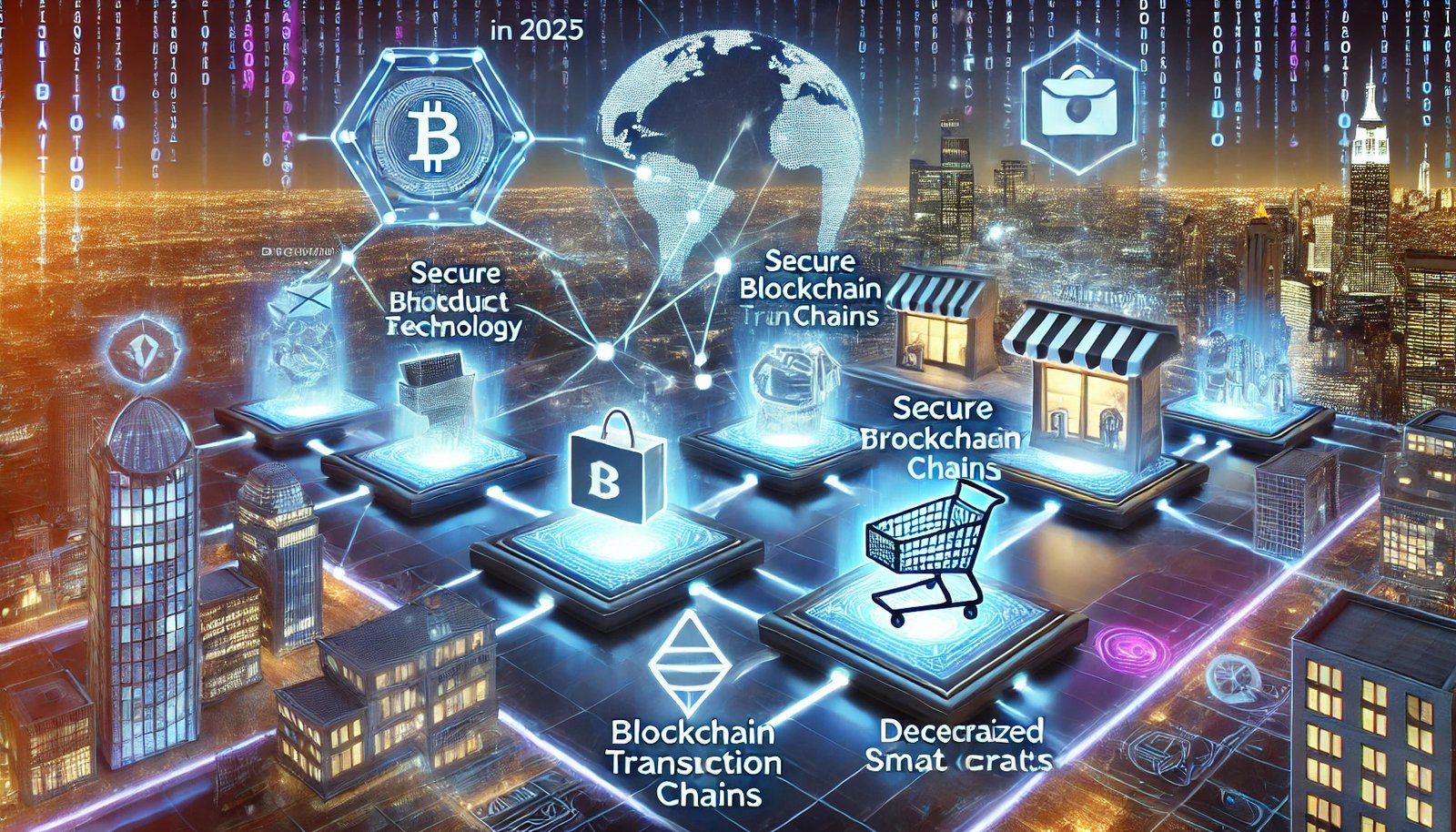What Are the Biggest Benefits of Blockchain for E-Commerce in 2025?
Blockchain for E-Commerce: Blockchain technology in e-commerce provides a secure, transparent, decentralized framework that enhances online transactions, reduces fraud, and improves supply chain management. In 2025, its biggest benefits include enhanced security, lower transaction costs, faster global payments, trust through transparency, and automated smart contracts. Blockchain also enables decentralized marketplaces, secure digital identity verification and blockchain-based loyalty programs. Additionally, it promotes eco-friendly and sustainable business practices by allowing verifiable tracking of ethical sourcing. These advancements make e-commerce more efficient, cost-effective, and reliable for businesses and consumers alike.
What is Blockchain for E-Commerce?
Blockchain for e-commerce refers to the use of decentralized ledger technology to improve security, transparency, and efficiency in online transactions. It helps businesses and consumers by reducing fraud, enhancing supply chain management, and enabling secure payment methods.

Key Benefits of Blockchain in E-Commerce
1. Enhanced Security and Fraud Prevention
One of the biggest challenges in e-commerce is cybersecurity. Traditional online transactions are vulnerable to hacking, fraud, and data breaches. Blockchain technology addresses these issues by providing an immutable and decentralized ledger where every transaction is securely recorded.
- Decentralized Security: Unlike centralized systems, blockchain removes the need for a single point of failure, making it nearly impossible for hackers to alter transaction records.
- Encryption and Smart Contracts: With blockchain-powered smart contracts, transactions are automatically executed based on predefined conditions, reducing the risk of fraud and unauthorized changes.
- Identity Protection: Customer data is encrypted, ensuring that sensitive information is secure and protected from identity theft.
2. Improved Transparency and Trust
Trust is a crucial factor in e-commerce, and blockchain enhances it by providing a transparent and tamper-proof record of transactions.
- Real-Time Tracking: Customers and merchants can track the entire transaction history, ensuring no discrepancies.
- Immutable Records: Once a transaction is recorded on the blockchain, it cannot be altered or deleted, eliminating fraudulent chargebacks and disputes.
- Supply Chain Transparency: Retailers can verify the authenticity of products by tracing their journey from production to delivery, reducing counterfeit goods in the market.
3. Faster and Cost-Effective Transactions
Traditional payment methods involve intermediaries such as banks and payment processors, which add extra fees and delays to transactions. Blockchain for e-commerce eliminates the need for intermediaries, allowing direct transactions between parties.
- Lower Transaction Fees: Blockchain transactions are peer-to-peer, reducing the costs associated with third-party payment gateways.
- Faster Cross-Border Payments: With blockchain, international transactions are processed in minutes rather than days, eliminating the delays caused by traditional banking systems.
- Instant Settlements: Payments are verified instantly on the blockchain, improving cash flow for e-commerce businesses.
Also read: Why Are Your Emails Landing in Spam (and How Can You Fix It)?
4. Efficient Supply Chain Management
Blockchain technology enhances supply chain management by providing real-time visibility into product movement, reducing inefficiencies, and ensuring authenticity.
- Traceability: E-commerce businesses can track products from manufacturer to consumer, preventing fraud and improving inventory management.
- Authenticity Verification: Customers can scan blockchain records to verify the legitimacy of products, particularly in luxury goods and pharmaceuticals.
- Automated Smart Contracts: Supply chain contracts can be automated using smart contracts, reducing manual paperwork and the risk of human errors.
5. Better Customer Experience and Loyalty Programs
Blockchain for e-commerce is reshaping customer engagement through innovative loyalty programs and personalized shopping experiences.
- Tokenized Loyalty Rewards: Businesses can issue blockchain-based loyalty tokens that customers can use across multiple brands, increasing engagement and brand loyalty.
- Personalized Offers: Blockchain enables secure data sharing, allowing businesses to offer personalized recommendations without compromising customer privacy.
- Frictionless Returns and Refunds: Refund processes can be automated using smart contracts, making returns hassle-free and improving customer satisfaction.
6. Decentralized Marketplaces and Reduced Dependency on Middlemen
Blockchain enables decentralized marketplaces where buyers and sellers interact directly without intermediaries.
- Lower Costs: By removing third parties, blockchain reduces costs associated with listing fees and commissions.
- Greater Autonomy: Sellers have full control over their pricing, policies, and customer interactions without relying on a centralized platform.
- Global Reach: Decentralized marketplaces enable borderless commerce, allowing small businesses to reach international customers without restrictions.
7. Prevention of Chargeback Fraud
Chargeback fraud is a common issue in e-commerce, where customers dispute transactions to get refunds while keeping the product. Blockchain for e-commerce eliminates this problem by providing transparent and immutable transaction records.
- Irrefutable Proof: Transactions on the blockchain are recorded permanently, providing clear proof of purchase and delivery.
- Smart Contract Execution: Refunds and returns are automatically processed based on predefined conditions, preventing fraudulent claims.
8. Enhanced Privacy and Data Protection
With growing concerns over data privacy, blockchain offers a solution that gives users control over their personal information.
- Decentralized Identity Verification: Customers can share only necessary information without revealing full personal details.
- GDPR and Compliance: Blockchain ensures compliance with data protection regulations by providing secure and encrypted storage.
- Elimination of Data Breaches: Since data is stored across multiple nodes, blockchain minimizes the risk of data breaches compared to centralized databases.
Key Challenges and Limitations of Blockchain Technology
While blockchain offers significant benefits, it also faces several challenges and limitations that impact its widespread adoption. Here are the key obstacles:
1. Scalability Issues
- Public blockchains, like Bitcoin and Ethereum, struggle with transaction speed and scalability.
- High network congestion leads to slow processing times and increased transaction fees.
- Solutions like Layer 2 scaling (Lightning Network, Rollups) are still developing.
2. High Energy Consumption
- Proof-of-work (PoW) blockchains require massive computational power, leading to high electricity usage.
- This raises concerns about environmental impact and sustainability.
- Some blockchains are shifting to energy-efficient consensus mechanisms like Proof-of-Stake (PoS).
3. Regulatory Uncertainty
- Governments worldwide are still defining regulations for blockchain and cryptocurrencies.
- Compliance challenges create legal risks for businesses adopting blockchain.
- Data privacy laws (like GDPR) may conflict with blockchain’s immutability.
4. Security Risks & Smart Contract Vulnerabilities
- While blockchain itself is secure, smart contracts can have coding bugs and vulnerabilities.
- Hackers have exploited weaknesses in DeFi projects, resulting in major financial losses.
- Auditing and improved security protocols are essential to mitigate these risks.
5. Adoption Barriers & Complexity
- Blockchain technology is complex and requires technical expertise to implement.
- Many businesses and users lack awareness or understanding of blockchain’s benefits.
- Integrating blockchain with existing systems can be costly and time-consuming.
6. Limited Interoperability
- Different blockchain networks operate independently, creating compatibility issues.
- Cross-chain communication solutions are still evolving, limiting seamless interaction between blockchains.
7. Cost of Implementation
- Developing and maintaining blockchain solutions can be expensive.
- Businesses may struggle with the initial investment and ongoing maintenance costs.
8. Data Privacy Concerns
- Blockchain records are transparent and immutable, which can be problematic for sensitive data.
- Businesses need solutions for private transactions while maintaining transparency where needed.
FAQ
How does blockchain improve security in e-commerce?
Blockchain enhances security by providing an immutable and decentralized ledger, reducing fraud, identity theft, and data breaches.
Can blockchain reduce e-commerce transaction costs?
Yes, blockchain eliminates intermediaries like banks and payment processors, leading to lower transaction fees and faster payments.
How does blockchain prevent chargeback fraud?
Blockchain records every transaction permanently, providing irrefutable proof of purchase and delivery, and preventing fraudulent chargeback claims.
What is the role of smart contracts in e-commerce?
Smart contracts automate transactions and agreements, reducing paperwork, preventing fraud, and ensuring seamless order fulfillment.
How can blockchain improve supply chain transparency?
Blockchain provides real-time tracking of products, ensuring authenticity and preventing counterfeit goods from entering the market.
Conclusion
In 2025, blockchain for e-commerce is no longer just a futuristic concept but a game-changing reality. From improved security and transparency to cost-effective transactions and efficient supply chain management, blockchain is transforming how businesses operate online. As more companies integrate blockchain into their e-commerce platforms, customers will benefit from increased trust, faster transactions, and a seamless shopping experience. Whether you’re a business owner or a consumer, embracing blockchain in e-commerce is a step toward a more secure and efficient digital economy.








